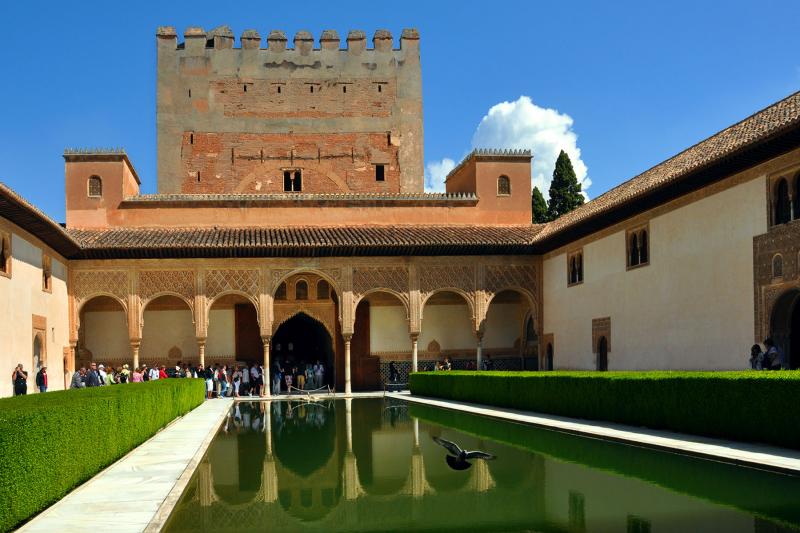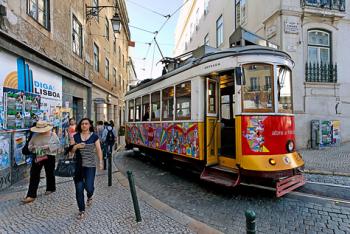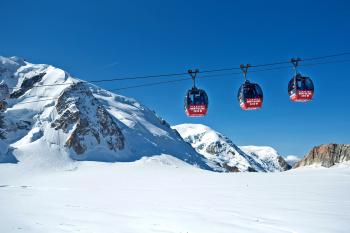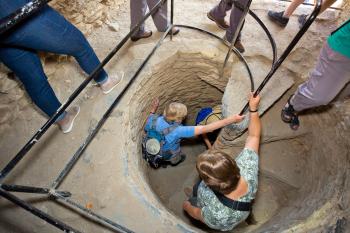What’s new in Europe in 2019
This item appears on page 41 of the May 2019 issue.
Looking at 2019, here are selected news items and warnings from a few of Rick’s recent articles. — Editor
• Like many travelers, in spring of last year I visited Barcelona, SPAIN, dreaming of seeing Antoni Gaudí’s breathtaking Sagrada Família church. When I got there, the ticket office was closed, with a posted sign: “No more tickets today. Buy your ticket for another day online.” Thankfully, I had known to book tickets in advance.
Along with Sagrada Família, Spain’s other sights to book ahead include the Picasso Museum, La Pedrera, Casa Batlló and Park Güell in Barcelona; the Palacios Nazaríes at the Alhambra in Granada, and the Royal Alcázar Moorish palace, Church of the Savior and the cathedral in Sevilla.
Barcelona’s Casa Amatller and Palace of Catalan Music as well as Salvador Dalí’s house in Cadaqués all require a guided tour, which also must be booked ahead. Advance tickets for the Dalí Theater-Museum in nearby Figueres are also a good idea. While it may be technically possible to buy tickets on site, I say reserve in advance. It’s much smarter.
In Pamplona, a new exhibit gives a behind-the-scenes look at the town’s famous bullring.
In the south of Spain, the cathedral in Sevilla now runs rooftop tours, providing a better view — and experience — than its bell tower climb. In nearby Córdoba, you can now climb the bell tower at the Mezquita, the massive mosque-turned-cathedral. But Córdoba’s 14th-century synagogue is closed for renovation.
Madrid’s Metro has a new rechargeable card system: a red Multi Card (tarjeta) is required to buy either a single-ride Metro ticket or 10-ride transit ticket.
• PORTUGAL has fewer blockbuster sights than Spain and nowhere near the crowds. The only sight where you might have a crowd problem is the Monastery of Jerónimos at Belém, outside Lisbon. (Buy a combo ticket at Belém’s Archaeology Museum to avoid the ticket line at the monastery.)
Riding in Lisbon’s classic trolley cars — a quintessential Portuguese experience — can also be frustratingly crowded (and plagued by pickpockets targeting tourists). A less-crowded option is trolley line number 24E, which is back in service after a decades-long hiatus. Although this route doesn’t pass many top sights, you can see a slice of workaday Lisbon. (Or, better yet, get your trolley experience in Porto, which has almost no crowds.)
On my last visit, I realized that Lisbon’s beloved Alfama quarter — its Visigothic birthplace and once-salty sailors’ quarter — is salty no more (except with the sweat of cruise groups hiking its now-lifeless lanes). The new colorful zone to explore is nearby Mouraria, the historic tangled quarter on the back side of the castle.
This is where the Moors lived after the Reconquista (when Christian forces retook the city from the Muslims). To this day, it’s a gritty and colorful district of immigrants, but don’t delay; it’s starting to gentrify just like the Alfama.
• In FRANCE, Paris’ most famous landmark, the Eiffel Tower, has a new look. A glass wall now rings its base for security reasons, with one access point at each side, meaning you can no longer wander freely under the tower. Visitors should allow an extra 30 minutes to go through screening. Also, summit tickets for the top are no longer available on the second level of the tower; it’s smart to buy them online.
At the Cathedral of Notre-Dame, timed-entry tickets are now required for the tower climb, even if you have a Paris Museum Pass. Reservations are available only on the same day (starting at 7:30 a.m.) on the JeFile app or at ticket machines on site.
Another Paris landmark, the towering and modern La Grande Arche de La Défense, has reopened, allowing visitors to take an elevator to the top. While it’s pricey, and there are better views elsewhere, just visiting La Défense district gets you into a fascinating slice of Paris that most tourists miss.
In the Dordogne, the Grotte de Font-de-Gaume prehistoric cave — one of the only caves in France where you can see original drawings, not replicas — no longer accepts reservations, making it next to impossible to get in. Local guides may have access to tickets; contact a guide at least six months in advance. As a much less frustrating and equally impressive alternative, consider the replica caves at Lascaux.
In the alpine resort of Chamonix, the valley’s most spectacular lift, the Aiguille du Midi gondola, takes you to magnificent views at 12,602 feet. To beat the crowds (and afternoon clouds), it’s best to ride the lift early, no later than 8 a.m. (Reservations are unnecessary if you arrive at the lift before 7:30.)
In happy news for small, family-run hotels and bed-and-breakfasts — and for savvy, budget-conscious travelers — French hotels listed on third-party booking websites no longer have to match those prices on their own websites, allowing them to offer lower rates or special upgrades if you book direct.
• In Berlin, GERMANY, advance tickets are now recommended for the DDR Museum, with displays about life in the former East Germany.
Visitors to the Reichstag, where the German parliament convenes, must show their passports for entry (in addition to reserving in advance).
In Munich, the Alte Pinakothek, a world-class collection of European masterpieces from the 14th to 19th centuries, has fully reopened after a long renovation. Now the Neue Pinakothek (paintings from 1800 to 1920) is closed for renovation for the next several years, but its highlights will be displayed at the neighboring Alte Pinakothek.
Visitors to “Mad” King Ludwig’s Neuschwanstein and Hohenschwangau castles in the Bavarian Alps must now pick up reserved tickets at least 90 minutes before their tour time. Though it’s best to book ahead, a percentage of castle tickets are set aside for in-person purchase, so if reservations sell out online, visitors generally can still get a ticket if they arrive early in the day.
Expect even more crowds in the Bavarian Alps in 2020, as the town of Oberammergau hosts the once-every-10-years Passion Play. Plan ahead; tickets are easiest to obtain in a 1- or 2-night package deal that includes hotel, ticket, dinner and a shuttle (www.passionsspiele-oberammergau.de).
In the Rhine River town of St. Goar, restoration at the mighty Rheinfels Castle means that parts of the grounds, including the tunnels, can be seen only with a guided tour. (Take a flashlight for the dark tunnels.)
• In Amsterdam, NETHERLANDS, renovations are complete at the Anne Frank House. Tickets go on sale two months in advance and are released gradually over the 2-month period. (If you miss out, keep checking back.)
If you can’t get into the Anne Frank, the Dutch Resistance Museum, just across town, is, for many, even more interesting (and never crowded).
The Van Gogh Museum also has a new ticketing system: all visitors, even those using a sightseeing pass, must book a timed-entry slot online.
• After a 7-year renovation, the National Museum in Prague reopened with eight permanent exhibits covering topics from evolution to the CZECH REPUBLIC’s 20th century. Admission to the museum, which towers over the city at the top of Wenceslas Square, includes access to its cupola, with great views over the “golden city of a hundred spires.”
Another fun option for fine Prague views is to ride the recently launched tram number 23. Like the popular tram number 22, it runs from the center of town, across the river and up the hill to Prague Castle… but with nostalgic 1960s-era cars.
• In Kraków, POLAND, Schindler’s Factory Museum seems busier every year, but smart travelers can beat ticket lines by booking an entry time at the information office (in the Cloth Hall in the Old Town’s main square).
The nearby Auschwitz-Birkenau Memorial, Europe’s most powerful look at a concentration camp, requires reservations. As time slots can fill up months ahead, travelers should book as early as possible.
If a given date is full, try the following: book a slot on a foreign-language tour (then split off and see the site on your own), pay for an excursion through a Kraków-based tour operator (consider www.seekrakow.com or www.discovercracow.com) or try showing up first thing in the morning (the museum opens at 7:30 a.m.).
• With the growth in Danube River boat tours, tickets can sell out for the riverside Hungarian Parliament in Budapest, HUNGARY (book in advance at www.parlament.hu). Without an advance ticket, travelers can try to buy same-day tickets at the visitors’ center ticket desk. On busy days, if any tickets are left, they’re likely to be for morning and late-afternoon tours.
• The AUSTRIAN capital of Vienna is hard at work improving its museum infrastructure. Several Vienna museums are closed at least until 2020 for major renovations: the city-history Wien Museum Karlsplatz, the Academy of Fine Arts Paintings Gallery and the Sigmund Freud Museum. During the Freud museum renovations, a temporary museum nearby will display some artifacts at a reduced entrance fee.
To avoid lines at Vienna’s Schönbrunn Palace and Hofburg Imperial Apartments, travelers can buy a Sisi combo ticket, which lets you enter the palace without a reserved entry time. It can be purchased in advance online (www.schoenbrunn.at) or in person at the Imperial Furniture Collection (Andreasgasse 7; www.hofmobiliendepot.at) in central Vienna, where ticket lines are shortest.
Rick Steves writes European travel guides and hosts travel shows on public TV and radio. Contact Rick Steves’ Europe (Edmonds, WA; 425/771-8303, www.ricksteves.com).





